British dancer/choreographer Akram Khan is back in Taipei this weekend, making his third appearance since 2002 in the Novel Hall Dance Series. This time he has brought Flemish-Moroccan dancer/choreographer Sidi Larbi Cherkaoui with him, and their 2005 masterpiece, Zero Degrees.
Khan and Cherkaoui met in 2000 and hit it off immediately but it took a few years for their schedules to clear enough so that they could work together.
The genesis of Zero Degrees, however, was a harrowing train trip Khan took several years ago with a cousin across the India-Bangladesh border. Khan discovered the body of an old man in his railway car and heard the man's widow beseeching passengers for help in getting the body off the train. No one responded; they were afraid of being accused of involvement in the man's death.
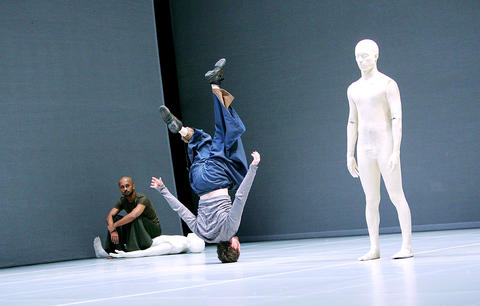
PHOTO: COURTESY OF TRISTAM KENTON AND JEAN PTERRE MAURIN
Khan wanted to help, but his cousin warned him not to risk getting tangled up in Indian bureaucracy. But he did have a moment of panic nevertheless as he watched the Indian border guards pass his British passport between themselves, fearing that he might somehow lose his passport, and by extension, his identity.
Khan has said in several interviews that Zero Degrees is about unseen moments and dual identities - the transition from life to death, from being someone to being no one - and "about the in-between space between everything."
Dual identities and transitions are a common bond between Khan and Cherkaoui. They are both Muslim, brought up in Europe and frequently explore cross-cultural issues in their work. While Khan was trained as a traditional Kathak dancer and then fused that with studies in contemporary dance, Cherkaoui is a talented acrobat, dancer and actor who choreographed for the Flemish dance/theatre collective Les Ballets C de la B until last year.
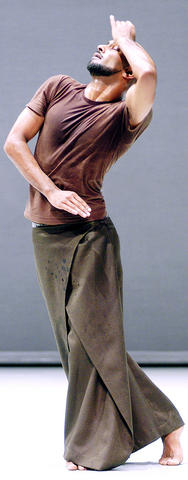
PHOTO: COURTESY OF TRISTAM KENTON AND JEAN PTERRE MAURIN
The pair is a study in contrasts physically. Khan is darker-skinned, compact and wiry, a tightly controlled whirlwind. Cherkaoui is taller, looser-limbed and so pale you might think he has spent years locked up in some windowless computer laboratory.
Zero Degrees begins with Khan and Cherkaoui sitting side by side at the front of the stage, recounting a tale of passports, trains and a body in perfect unison, with tightly synchronized gestures that are at once an extension of each other's movements and mirror images.
Cherkaoui has said that it took them three weeks to achieve five minutes of synchronized choreography, something to keep in mind while watching them weave their arms, hands and later their bodies through the air.
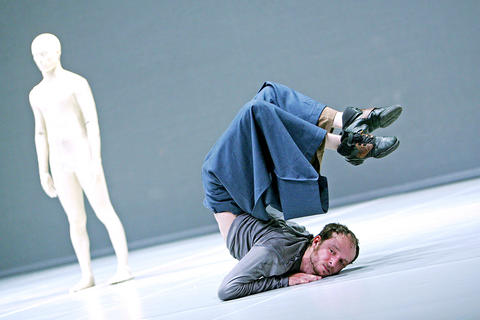
PHOTO: COURTESY OF TRISTAM KENTON AND JEAN PTERRE MAURIN
While it is just the two men who can be seen on the stage, the piece was a team effort: Khan, Cherkaoui, musician and composer Nitin Sawhney and sculptor Antony Gormley, who did the sets and created the white foam dummies that get dragged and pummeled in the course of the dance. Four musicians are heard, but barely seen behind the white scrim that serves as a backdrop.
Zero Degrees premiered just days after the London subway bombings in 2005. Khan has said that the bombings made the piece even more relevant for him because as a Muslim of Bangladeshi heritage, he became very conscious of his skin, his color and his bag, when making the 90-minute commute from his Wimbledon home to his south London office.
He readily admits his work is becoming darker. He's also striving to make it more real. Certainly death has become a reoccurring theme, as it was in Lost Shadows, the piece he created for Cloud Gate Dance Theater earlier this year.
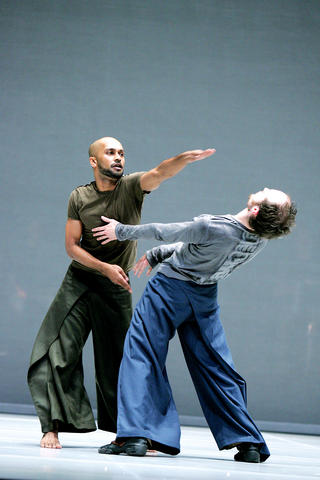
PHOTO: COURTESY OF TRISTAM KENTON AND JEAN PTERRE MAURIN
"For me it's a form of therapy to create a piece of work, a way of dealing with what's happening in the rest of the world," he said at a forum in Taipei in March.
With Zero Degrees, he told another interviewer, "each time I do the piece and I say the story, it's almost like a therapy."
Khan took three years "out" from his company to create a trio of duets. Zero Degrees was the first. The second was 2006's Sacred Monsters with French prima ballerina Sylvie Guillem. The third, Gnosis with French actress Juliette Binoche, will premiere next spring in London.
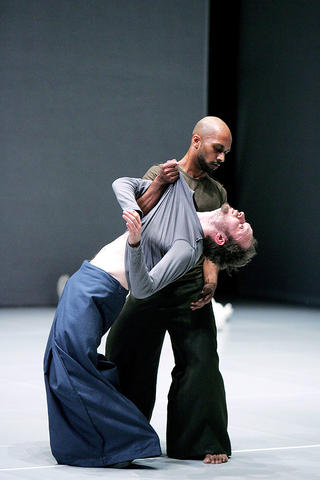
PHOTO: COURTESY OF TRISTAM KENTON AND JEAN PTERRE MAURIN
"Shifting back and forth like a tennis ball, I exist when I am on the move," he said. He certainly has been on the move this year, bouncing around the globe.
"Always in motion, [it's] always the movement," he said. "When I stop [working on a piece], when it becomes set in concrete, then I lose who I am."
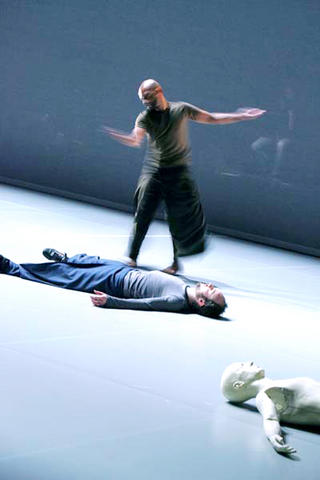
PHOTO: COURTESY OF TRISTAM KENTON AND JEAN PTERRE MAURIN

The canonical shot of an East Asian city is a night skyline studded with towering apartment and office buildings, bright with neon and plastic signage, a landscape of energy and modernity. Another classic image is the same city seen from above, in which identical apartment towers march across the city, spilling out over nearby geography, like stylized soldiers colonizing new territory in a board game. Densely populated dynamic conurbations of money, technological innovation and convenience, it is hard to see the cities of East Asia as what they truly are: necropolises. Why is this? The East Asian development model, with

Desperate dads meet in car parks to exchange packets; exhausted parents slip it into their kids’ drinks; families wait months for prescriptions buy it “off label.” But is it worth the risk? “The first time I gave him a gummy, I thought, ‘Oh my God, have I killed him?’ He just passed out in front of the TV. That never happens.” Jen remembers giving her son, David, six, melatonin to help him sleep. She got them from a friend, a pediatrician who gave them to her own child. “It was sort of hilarious. She had half a tub of gummies,

The wide-screen spectacle of Formula One gets a gleaming, rip-roaring workout in Joseph Kosinski’s F1, a fine-tuned machine of a movie that, in its most riveting racing scenes, approaches a kind of high-speed splendor. Kosinski, who last endeavored to put moviegoers in the seat of a fighter jet in Top Gun: Maverick, has moved to the open cockpits of Formula One with much the same affection, if not outright need, for speed. A lot of the same team is back. Jerry Bruckheimer produces. Ehren Kruger, a co-writer on Maverick, takes sole credit here. Hans Zimmer, a co-composer previously, supplies the thumping
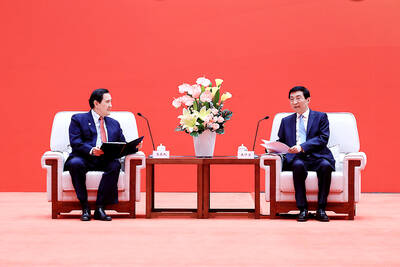
There is an old British curse, “may you live in interesting times,” passed off as ancient Chinese wisdom to make it sound more exotic and profound. We are living in interesting times. From US President Donald Trump’s decision on American tariffs, to how the recalls will play out, to uncertainty about how events are evolving in China, we can do nothing more than wait with bated breath. At the cusp of potentially momentous change, it is a good time to take stock of the current state of Taiwan’s political parties. As things stand, all three major parties are struggling. For our examination of the